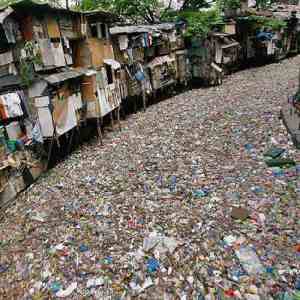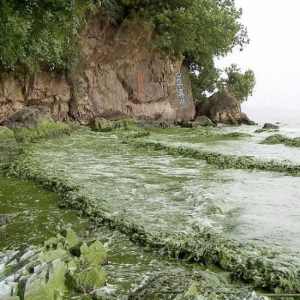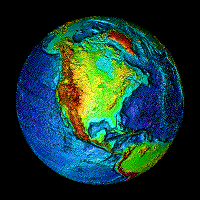Flip-flops washed ashore near the Arctic Circle
“We saw flip-flops washing ashore on these islands in far northern Norway near the Arctic Circle,” said Cousteau, an environmentalist.
“People don’t wear flip-flops in the Arctic, at least not if they’re sane.”
Half a million volunteers around the world retrieved 10,239,538 pieces of trash from our ocean, lakes and waterways in a single day, September 19, 2009. The trash weighed about 3.4 million kg (7.4 million pounds), a tiny fraction of the total marine litter. Most of marine trash starts on land.
Clean This!

Citarum River, Indonesia. More than 500 factories along the banks of the 330km long Citarum River, contribute to this man-made disaster. Source: Sea-way. Click image to enlarge.
Highlights from The 2009 International Coastal Cleanup
Volunteers around the world covered 14,827 miles, more than six times the length of the Mississippi river, and found:
- 336 marine animals, including 138 birds, entangled in marine debris 120 of the animals were still alive and released. Fishing line and nets were some of the most dangerous items, trapping over 200 animals
- 512,517 cups, plates, forks, knives and spoons enough to provide a full set of dinnerware to over 100,000 people
- 8,881 bottles of oil/lube during the cleanup. This is the amount that would be used to change the oil in nearly 12,000 mid-sized cars
- More than 40 percent of all trash was collected in the United States
- About 20 percent of the garbage collected threatened public health, and most debris were a threat to marine animals.
Clean This!

Lake Tai, the 3rd largest lake in China, is covered in green algae. About 3,000 factories located on the shores of Lake Tai have turned the lake into one of the most polluted in China. Click image to enlarge.
What If:
What if the same number of volunteers removed the same amount of trash from the ocean every day, instead of just one day of the year?
It wouldn’t make the slightest bit of difference.
Why NOT?
For three reasons:
- First, the amount of litter retrieved would still constitute only a tiny fraction of the overall trash in the world’s waterway.
- Third, nearly all of the sewage, agricultural, industrial, chemical/toxic pollution that enter the waterways dissolve in the water and become invisible.
The Problem?
To stop the trash entering our oceans and waterways, you have to stop producing waste. There’s no other formula that works.
The source of our oceans’ grave illnesses are the system of exponential growth economy, that cannot thrive without generating mountains of harmful waste. You cannot stop the oceans from dying without first changing the economy from its current state, into an eco-centered Oikonomia.
How Effective is the Work Done by Ocean Conservancy?
Coca-Cola, the Dow Chemical and the likes that have embedded Ocean Conservancy ares the Praetorian Guards of the predatory economic system. It’s difficult to see how those companies would seriously act against their own monetary interests.
Related Links:
- Oceans, Where Life Started, Are Dying – Part IV : Researchers found evidence of corrosive water about 20 miles off the west coast of North America from Canada to Mexico.
- Human carbon emissions make oceans corrosive : ‘Carbon dioxide spewed by human activities has made ocean water so acidic that it is eating away at the shells and skeletons of starfish, coral, clams and other sea creatures …’
- The Eight Steps that Help Kill More of Our Fish : How Your Car’s Exhaust Emissions Helps Create Dead Zones and Kill Our Fish.
- Global warming could starve oceans of oxygen: study : Areas of the eastern Atlantic and Pacific Oceans with low amounts of dissolved oxygen have expanded in the past 50 years, apparently in line with rising temperatures.
- The Floating Toxic Garbage Island : A patch of garbage twice as large as the continental United States and dubbed the Great Pacific Garbage Patch floats in the middle of the Pacific Ocean in North Pacific Gyre.
- Oceans, Where Life Started, Are Dying – Part III : Tourism: The Most Destructive Human Activity After Warfare
- Oceans, Where Life Started, Are Dying – Part II : Major Problems: Fertilizer Runoff; Tourism; Coastal Developments [and Ocean Warming due to climate change]
- Oceans, Where Life Started, Are Dying – Part I : Our Oceans Are Now Dying!
Serial No 1,570. Starting April 2010, each entry on this blog has a unique serial number. If any of the numbers are missing, it may mean that the corresponding entry has been blocked by the authorities/Google in your country. Please drop us a line if you detect any anomaly/missing number(s).








